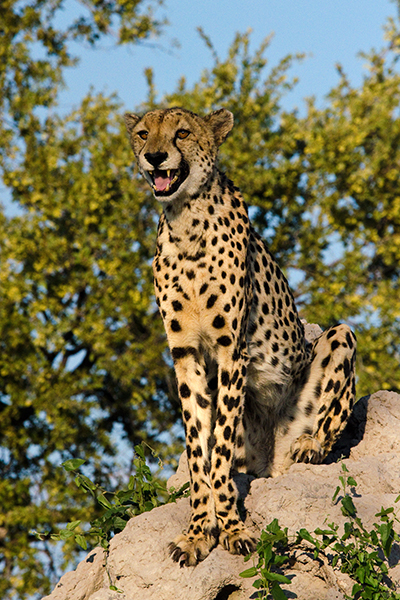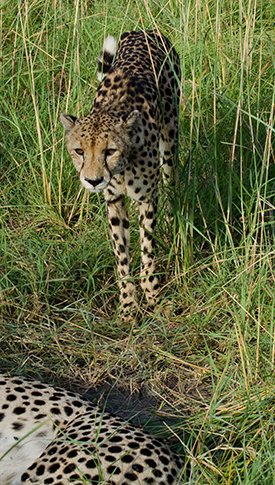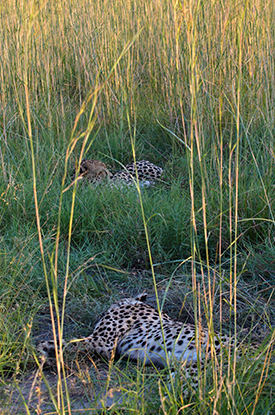DESERT TO DELTA -- THE ESSENTIAL BOTSWANA
Recently (the spring of 2016) Willis and Cheryl returned to Africa after 15 years and toured Botswana, including the Central Kalahari, Okavango Delta, Moremi Game Reserve and Chobe National Park. I am creating a complete new website dedicated entirely to this extensive expedition; until that time please visit this link to browse, review and download the e-book or PDF version; perhaps consider buying the hard copy edition detailing our adventure!
"The Curious Mourning Cheetah of Kwando"
"Let’s go out and see what's new in the zoo," our ebullient guide Spencer joyously vocalized as six guests, Spencer and spotter/tracker "PK" boarded the completely open LandCruiser and slowly motored away from our accommodation at Kwando Safari's flagship property –- the remote yet elegant Lagoon Camp in the heart of Botswana's vast Kalahari Wilderness, adjacent and somewhat north of the Kalahari Desert and just north of the wildlife-rich Okavango River Delta, in the Linyanti Swamps region. We had previously visited both the Kalahari Desert and Okavango Delta areas as well, starting in the Kalahari Central Game Reserve, a Federally protected plains and salt pan-like expanse the size of Massachusetts. We shared this huge remote tract with perhaps two-dozen intrepid human visitors and vast herds of grazing oryx and springbok and significant populations of giraffes and hartebeest; all of which were closely followed by various apex predator species -- cheetahs, leopards and lions. We watched a cheetah unsuccessfully stalk a nervously grazing springbok. From our deck at night we reveled at the roars of a nearby resident lion pride while enjoying some of the darkest skies on Earth. Following several days and nights there, we proceeded to the heart of the vast inland Okavango River Delta, settling in for four days and nights at Kwando Safari's Kwara Camp. After a puddle-jumper-type air transfer we arrived at Lagoon Camp, located on the private Kwando concession in northern Botswana and on the border with Namibia. The terrain here at Lagoon was a varied wetland – we visited during the shoulder season, annually after the rains but before the arrival of the floods emanating from the mountainous Angola Highlands region several countries north and west. Once the floods come, overland driving becomes difficult and the wildlife generally retreats to higher ground, called “islands” by the locals. These islands are significant because they commonly are host to larger deciduous Mopane hardwood trees and adjacent densely forested areas. Otherwise, the sandy terrain is relatively flat; it is littered with small ponds, rivulets and bushes. One of the most significant features of this landscape are the characteristic termite mounds, often three to five meters in height. And commonly seen on top of these mounds, surveying their domain, are cheetahs. "Look," Spencer exclaimed – "there’s a cheetah on the mound." He briefly stopped the vehicle so San Bushman spotter "PK" could move from his highly visible yet somewhat vulnerable seat atop the left front fender and into the left front passenger seat. Spencer drove forward, off the track (hardly a road, more like two ruts in the ever-present Kalahari sand) cross-country. We crept slowly up to the cheetah. Spencer was particularly diligent to approach cautiously, not necessarily because of any danger (although the cheetah, from his elevated perch, could have easily leapt directly into our vehicle), but more out of his timeless respect for all of the wildlife, this attitude garnered through a lifetime of wilderness living and guiding. With an eye on the ambient lighting and sun angle, Spencer positioned the vehicle for maximum "photo-ops" and artistic composition. I fiddled with my cameras (two different bodies with lenses of varying magnifications and fields-of-view); Cheryl pulled out her sketchpad. We all had a window(less) seat. The magnificent cat yawned, displaying a splendid set of teeth (following page), moved about slowly while on the wide mound top but then stood straight up (second following page) and let out what my journal log entry described as a "weird, soft crying sound." Spencer contemplated that this was an attempt for this male to communicate with his companion, another male cheetah. Spencer also noted that earlier in the season there was yet a third animal, but he had died. Sometimes male cheetahs hunt together, mostly out of a concept of protection in numbers. Although powerful predators, they are far smaller then leopards and frankly tiny compared to the ever-present super-dominant lions. As such then, it's not surprising that the male cheetahs often stay together as a hunting unit. (Several days earlier, we observed another cheetah very nervously consuming a small impala antelope. He ate all he could in one sitting – his stomach so visibly bloated after the affair that he could only move perhaps five meters away from the kill before collapsing; his bulbous belly continuously scraping the ground as he waddled toward his temporary resting place.) After the moaning event, the male cheetah moved down from the top of the termite mound and tread nervously in the tall, golden late-afternoon grass, finally settling down in a somewhat concealed non-descript area perhaps fifty meters from the mound. Spencer cautiously moved our vehicle toward him. The animal cried out again. Yes, even for Spencer, this was new. The moaning male cheetah had settled down beside a recently deceased cheetah – his companion! The living cat occasionally reviewed the carcass; sniffing and even licking its face. Spencer lamented that the remaining cheetah had a bad limp, and likely would expire soon as well, since he did not have all the characteristics generally necessary to solitarily hunt.
During our time at Lagoon Camp, we would revisit this site of melancholy. At first we were able to locate the original mourning Cheetah, often sitting with his deceased partner, but after several visits he had disappeared into the ghostly African wilderness.
About the book . . . Desert to Delta -- The Essential Botswana is chock full of Willis Greiner's powerful and evocative images of the extensive wildlife experienced in the Kalahari Desert, Okavango Delta and Chobe Riverfront. His text and photographs are enhanced with beautiful and informative illustrations by Cheryl Price. Also included in this content-laden edition are useful links to additional African safari resources and advice. Included are close-up photographs of much of the region’s wildlife, as well as photographs of unique astronomical perspectives, taken at night as the local lions roared! Cheryl Price’s lovely drawings, created on safari and in the presence of much of the area’s dramatic mega fauna, are a delightful addition to the book. Greiner has also provided several provocative narratives, including "A Modified Definition of Wilderness" (reflecting on a slightly different concept of the African backcountry) and "The Curious Mourning Cheetah of Kwando," an interpretation of the very real emotional experience of a cheetah losing his partner. Greiner and Price’s many wonderful encounters with the outstanding hosts and guides of the Botswanian backcountry are featured in stand-out boxes scattered throughout this edition. Within the appendices are sections on suggested reading, localized star charts and Willis’ helpful personal list of recommended photographic gear.
Or -- click this text to access the book directly from Blurb.
[all photographic and narrative content © Willis Greiner Photography, 2017, drawings © Cheryl Price Originals, 2017 |


